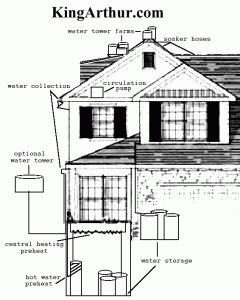Canola Harvest

Combine Harvesting Canola
Canola Seed
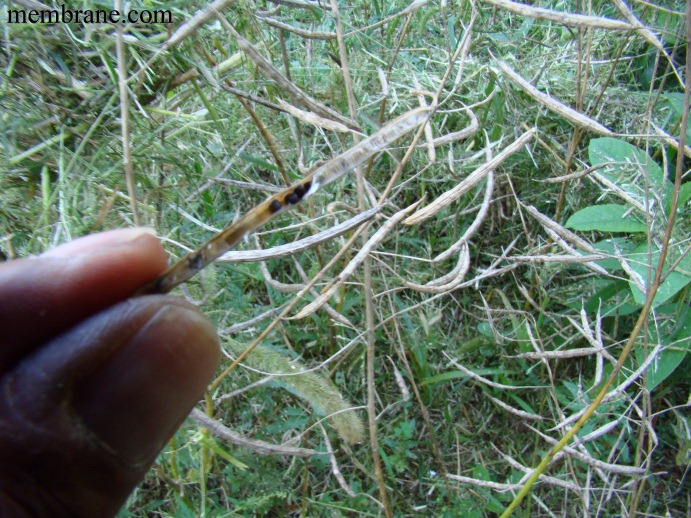
Canola Seed In Pod
Sustainable Living?
I ask:
Can anyone offer up a short list of what humans need to sustain life?
x amount of potable water
x amount of calories / food
oxygen
shelter from the elements
?
COMMENTS
Mike:
For a specified amount a time ?
What is the gender age and weight of the person?
Are they carieng for themselves or are there others involved?
What is the region they will be in? Climate cam play an important part.
For me… by myself… with a good knife and a full pack, I’m good forever.
You ask why? Because God is on my side ![]() :)
:)
Rick:
A good friend of mine has answered this by saying, “Brown eyes, big thighs, and Budweiser” (but he’s been know to exaggerate.)
Ed:
Peace of mind
Now, in order to achieve PEACE OF MIND, what we need is balance across the globe. No need in this time for anyone to be thirsty or hungry. To sustain what is most important is to just keep it clean! In order to keep it clean, greed in this world has to end.
Leroy:
Not possible.
ie how long?
and who’s gonna take it away from you?
Love is all you need.
Dr. IQ:
Sleeping under open skies and eating barley bread is ample for every soul who will taste Death… Period !
Ruthanne:
My list for sustaining life –
1. People need people, well at least for some.
2. Water
3. Food
4. Air
5. Healthy Body, skin.
6. Nature and a good play-mate.
Admin:
Ah ha! I was wondering if anyone was going to bring up reproduction being necessary for sustainability?
Mom:
Somewhere years ago I had to memorize a “Hierarchy of Needs.” I think it
might have been in psychology class at Ursinus.
Maslow’s Hierarchy of Needs
The list of needs is order like a pyramid. At the base of the pyramid are physiological needs –
Breathing
Homeostasis
Water
Sleep
Food
Excretion
Sex
Clothing
Shelter
Economics Of Alternative Energy Consumption
This article is part of a series on The Waterfall House energy experiment.
At the beginning of a this experiment, an economist said, “Using water will be cheaper than using electricity to control our environment.” A scientist said, “It can not be done.” So, the economist set-up the scientific experiment in an attempt to prove the economics of — substituting the sun (solar), the rain (hydro) and geothermal techniques for traditional electric and fossil fuel consumption.
After several months, the economist was pleased that the scientific experiment was a success. Cooling a home with evaporation is much cheaper (more economical) than with electricity. In the winter months, similar techniques and be used to conserve on traditional heating methods.
Independently, the scientist happened upon the same economic theory.
This confirmed a major breakthrough. Substituting water for electricity had not been done before. It was like comparing apples to oranges. Now, it was like comparing apples to apples… or, perhaps like turning water to wine?
The confirmation came when the scientist said to the economist, “Yesterday I was outside washing the windows (yes i checked to see they were shut first.)
I began to think… the air conditioning is humming… the sun is shining bright… and the water dries rapidly. Wow! Every cubic foot of water that evaporates takes 61000 BTU with it.”
Now, lets think about air conditioning efficiency. There are mandated air conditioner SEER ratings of 10. That means, the air conditioner has to move 10 BTU of heat out of a house for every BTU of electric that it uses.
Every cubic foot of water evaporating off the side of the house makes the air conditioner eat 6100 less BTU of electric. That is 1.78 KWh.
Electric is approximately 8.5 c/KWh here.
So, every cubic foot of water that evaporates saves 15 cents of electric.
Water is 4c/cubic foot here.
You can do the rest of the math.
There are worse ways to spend the afternoon… and seeing that today is another nice hot sunny day… and that I have to hose out my recycling trashcans…
I broke the hose out and thought some more. The first thing I thought of was a cold beer.
That taken care of, I set it down and crawled behind the groaning air conditioner compressor in back of the house.
I see a 15 amp 220V circuit, actual running rating is 12 A (with various fusing options for startup current… this does not include fan motors indoors… therefore, I will use the 15 A number.) That works out to be 3.3KW unit… 3.3KWh per hour… 1 cubic foot of water saves 1.78 KWh. Every cubic foot evaporated shuts my air conditioner off for 32 minutes. I crawled out, took a deep swig, smiled broadly and set the hose on ‘kill’.
Of course, this is an experiment. I will need to keep track of indoor and outdoor temperature and humidity, and water usage and a bunch of other stuff like air conditioner running time… and utility bills… in my copious spare time… watch this space for further details.
Then, I pondered. Should I say to myself, “SHHHHH! Don’t tell anyone!” After all, what happens if everyone starts doing it? This is one reason I insist on using waste or re-cycled water. Because if everyone starts using tap water, the price of water and of electricity will likely strive for equilibrium. (Water companies will be able to demand a higher price from you. What would you pay? Up to 14.995c/cubic?)
Cooling System Formulas
This article is part of a series on The Waterfall House energy experiment.
The Waterfall House had been up and running for several months.
After having two record days of heat in a row, I was asked:
Q: HOW IS YOUR COOLING SYSTEM WORKING NOW!!!???
A: Great! The details follow. In a nutshell — Yeeha! Unfriggin’ believable!!!
60 gallons of water evaporated so far today.
It feels like each level of the house is equivalent in temperature to being one level lower. (i.e. the 3rd floor feels like you are on the 2nd floor… 2nd feels like you are on the 1st… and the 1st floor feels like you are in the basement)
That is about a 10-20 degree drop downstairs. On the 3rd floor, it averages about 20-30 degrees cooler with the system running.
While Sidd was in town, he was gracious enough to help my pea brain through the math (see below.)
On a typical hot day, I’m evaporating 40 gallons of water. The math suggests that each gallon of evaporated water is equal to running a typical air conditioner for 1 hour.
Or, you could say I’m saving 40-60 air conditioning hours a day.
Likewise, I would have to run 40-60 air conditioners for 1 hour to achieve the same affect.
THE FORMULAS
L = latent heat of evaporation / unit Volume
Q = heat removed
Q = VL
L = 8,094 BTU / gallon
notes:
1 BTU = 1055 Joules
1 BTU heats 1 pound of water by 1 degree F
L fusion = 80 calories (to freeze water)
L evaporation = 536 calories
1 calorie = 4.2 joules
1 calorie raises the temperature of 1 gm (or cc) of water by 1 degree C
1 US gallon = 3.8 liters = 3800 cc
About Waterfall Homes and Aqua Living
This article is part of a series on The Waterfall House energy experiment.
Using steam, solar and hydro to help reduce your energy consumption has many benefits. Two of the most obvious benefits are saving money and reducing your “footprint”.
Following are more ideas:
I. What Living In A Waterfall Does
1. cools the house evaporatively (roof irrigation)
2. creates hot water to preheat domestic water and central heating
3. provides garden irrigation
4. increases fire safety
5. delivers an alternative domestic water source
6. helps promote the health and wellness benefits of sun light
II. Main Elements
A. water tower farms
1. bottom feeding water towers
2. siphon feeding water towers
B. water:
collection
storage
distribution
recycling
The out-of-pocket cost to make my dream come true — $338.00 (USD)
(The hidden costs: there’s been some minor water damage, my foot fell through the ceiling, and I got a blood blister on the roof of my mouth while siphoning.)
Improvements To Be Made
Re-cycled Gray Water
I’ve been giving lots of thought to water usage… how you were saying it would take too much water.
That has been a fear of mine… so, I’ve worked on a plan to recover household waste water.
I’ve started sticking a 5 gallon bucket in the shower with me. I try to capture water that is not overly gray (little or no soap… and NO human contaminants.)
This is fairly easy to do. When I’m getting the water temperature ready… or, when I’m just standing there… the water that misses me… goes into the bucket.
Surprise! There was more waste water than I could have imagined (the 5 gal. bucket fills up real FAST.)
PYRAMIDS
The 5 gallon buckets on the roof don’t always empty. (This is due to a wide variety of elevations.)
I found stacking the water towers like a pyramid solved at least 2 problems:
1. the bucket fully drains
2. the water can flow to higher parts of the roof. Raising the right bucket to the top of the pyramid made the water flow to my hard to reach areas.
LOCKS
Getting water from lower elevations to the roof can be done without too much trouble by creating a series of levels (or locks.)
Either several pumps, or one pump moved from location to location, can “step” the water up 10-20 feet at a time.
I used one pump (cost 88 dollars).
Stay tuned….
Introducing The Waterfall House
Prelude
Introduction
Q: Is a waterfall house possible?
1. Is it physically possible?
2. Is it economical?
A: Yes.
The escalating global energy crisis, and resulting climate crisis, is a problem worth solving. My preference would be nuclear fusion; however, the scientists have told me it is many years away. In fact, it may not ever be possible on Earth. It just seemed crazy to me that we could not use that giant nuclear fusion plant we call the Sun.
What if I designed and engineered a living environment that:
1) was fun to live in
2) overcame some of the negative impacts of global warming
3) helped create a positive impact against further climate change
In general, what if my living environment was healthy for humans, as well as, contributed to Earth’s sustainability.
A vision came to me:
Recycle rain water and wasted “gray” water to irrigate my roof.
The Original Idea
1. A perforated hose is strung along part of a black asphalt shingled roofline. On sunny / hot days water trickles down over the roof.
2. An existing gutter is used to collect water. A hose with a special fitting over the end (funnel and filter combination) is placed either inside the spout or outside its bottom. When it rains, the system fills with water. Once the system has filled, excess water runs off through the existing drainage.
3. On days when the system is in use, a solid black hose carries the water around the existing water heater. The hose is wrapped around the heater like an insulating blanket.
4. A holding tank(s) stores the water.
5. A pump starts the flow of the water.
Summary:
Evaporation cools the house. The hot water is used for heating. A more sophisticated design would capture the by-product, steam, and convert it to stored energy.
Detail For Water Tower
A five gallon bucket sits on top of the roof. A feeder hose brings in water to store in the five gallon bucket. As water is needed, it is released through a bleeder or sprinkler hose.
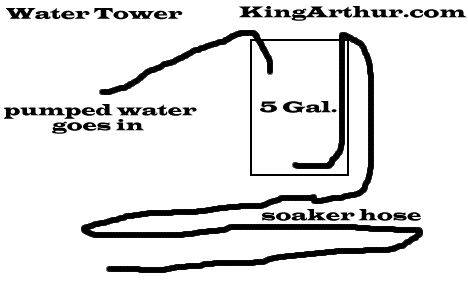
Five Gallon Bucket Watertower
Detail For Pumping Station
A large trash can is used as a safety net. Inside the safety container is a 5 gallon bucket filled with a pump and water. When the 5 gallon bucket fills with water, it pumps it to the water tower. The water released from the water tower is then recycled back through the pumping station.
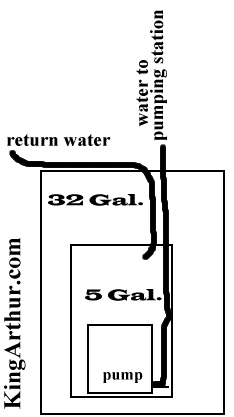
Pumping Station to Pour Water Over the Roof (or Against the Exterior Walls)
The Dream Sketch
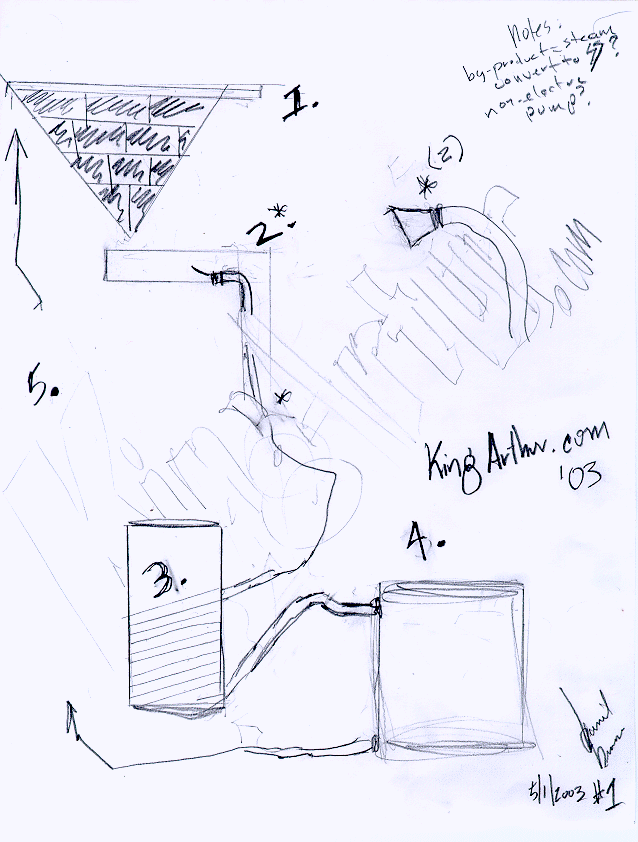
The Original Vision of the H2O Fusion Climate Control System
When it rains, additional water is collected through the rain spouts and stored in rainbarrels for use on hot, sunny days.
The On-going Experiment
About Waterfall Homes and Aqua Living
Cooling System Formulas
Economics Of Alternative Energy Consumption
The Hydro Fusion Heating and Cooling System
Introduction
Yes. For many years, I have imagined different types of living environments, such as “Tunnel Under.” Tunnel Under living has to do with living underground. It would be a last resort to escape from environmental threats. As a child, I did imagine these events would occur in my life time. Sorry to say, most scientists, the EPA and many other governments believe human induced environmental threats are of eminent danger. (see Global Warming: Biggest Health Threat and EPA: Greenhouse Gases Pose Threat to Public Health)
Over the last several years, I’ve considered many designs and expressions of these ideas. First, I started planing to move into the basement. The more I thought about it, the more I dreaded it. Right now, my office is on the top floor. I look out over the tree tops. It is sort-of like being in a tree house. The view is beautiful. The feeling is uplifting. How could I move into the basement? Waaa! The reality of an increasing temperature in my working area has forced me to take action — forcing me to turn my dreams into reality.
Ah ha! That is when another brighter vision occurred. I had to think of a way to prolong my stay in the loft. Imagine your dream house. Instead of tunneling down into a dark hole, why not utilize being exposed to the elements. I could use my roof for light and water to help solve the problem of human induced climate change. — living in a waterfall. Now, that would be a beautiful thing. However, I couldn’t figure out how that would ever be real (at least not for the masses.)
The more I thought about it, the more I liked the idea of living in a waterfall. Were there is a will, there is a way! The Waterfall House
Forecasting: The Impact of Governance and Globalization
Based on The Economics Of Y2K
Abstract: The Tunnel Under Thesis
Planning and control are two traditional functions of management. Once a plan has been determined, it must be carried out. The cost involved in controlling the plan is dependent on the quality of the plan. The quality of the planning function depends largely on the ability to forecast events and trends with accuracy and precision.
Forecasting methodologies, such as qualitative analyses, time series analysis & projection, and econometric models, are widely used throughout U.S. businesses and governmental agencies.
The chaotic relationship of three key factors is likely to make traditional forecasting tools and methods increasingly unreliable:
* control of digital distribution
* security
* pollution
Tunneling & Veiling
The result of these three ingredients in the stew will likely result in a figurative, as well as literal tunneling underground. Another term for this type of activity is decentralization.
Control Of Digital Distribution
The forecast for digital distribution suggests that existing systems for controlling data communications and digital distribution are failing. As the owners of the traditional systems attempt to maintain control, they will actually be the driving force in developing underground technologies.
Examples include peer-to-peer networks and music swapping websites.
Security
When a government wages a war against drugs, or terror, or any other globally organized illicit activity, there is often a significant amount of collateral damage to their own citizens, to their infrastructure and even their system of governance.
The Patriot Act and the Homeland Security Department are examples of the U.S. Federal Government’s attempt to control based on their forecasting methods. However, the side-effects actually force all people, both good and bad, to decentralize their activities. The result is encrypted data tunnels and underground communication networks.
State governments are experiencing more difficulty controlling their tax receipts (in large part due to digital distribution of goods and services). As states try to control taxes based on your location, they will encourage the development of decentralized business systems.
This complicates the already inadequate and convoluted accounting systems in use by municipal government for over a century. For example, until 1985, many municipal governments did not have a fixed asset accounting system, nor did they have even an accurate inventory of all their assets. Therefore, the taxing authorities had no factual basis on which to tax their constituents.
Pollution
Pollution (greenhouse gases being a large threat) is causing irreversible climatic change. Some people consider the clearing of land to be a form of pollution. Whether you call it pollution or not, deforestation certainly compounds the global warming problem. Again, chaos theory suggests that meteorological forecasting will be affected in much the same way as economic forecasting. And, since the weather is so closely tied to the economy, the intensity in volatility is likely to be felt in both areas. [Note: although the Earth's average temperature may be rising slightly, the volatility for any given location is rising dramatically.]
Global warming, insect borne viri, nuclear fallout, reforms to flood insurance, and other weather related phenomena suggests a more literal tunneling under.
The Economics Of Y2K
The following thesis was started in 1998. As a group heavily involved in IT (information technologies), we were curious as to the implications of the Y2K (year 2000) computer “bug”. At that time, most computers had been built with the ability to handle dates using two digits for the year. When the clocks in computers rolled over from December 31, 99 to January 1, 00, it was feared there would be massive disruptions.
Though the public did not feel much of an impact the day of the new millennium, in fact, the Y2K problem was real. In hindsight, the reason the public did not notice was because the problem had been fixed prior to the rollover date. Governments and businesses spent more time and money correcting the problem than any other instance in history. It was the U.S. governments biggest financial outlay since the Vietnam War.
Our interest was not so much about the technical problem being corrected, rather, how the problem was being corrected. How would spending all the money correcting the problem impact society? How could we forecast the economy?
The conclusion we came to:
though spending all the money would help solve the short term problem, it would cause larger longer term problems.
In large part, we had observed that massive amount of funds were either being misallocated or being allocated toward inferior substitutes. Often, consultants were being paid for inaccurate information which is not a productive allocation of resources. Often, computers with reliable operating systems were being replaced with computers running on less reliable operating systems. (i.e. DOS being replaced with Microsoft) This type of “throwing good money at bad” inevitably caused an exponential “snowball” effect. Thus, our economic forecast was for deteriorating conditions.
One of the main reasons we conducted this study was to apply the results to what we considered a larger problem — forecasting the economics of global warming. As it turned out, the forecast was/is deadly accurate.
The Economics Of Y2K
(a cost and benefits study of the year 2000 computer problem)
Abstract.
Pursuant to the work of Wonnacott and Wonnacott (An Introduction To Microeconomics, McGraw-Hill) in the area of technology, growth and employment, how does economic theory explain Y2K?
Once an economy puts it’s unemployed back to work, there is a limit to what growth can occur without severe consequences. One of the only known methods to grow an economy past this limit, is to improve technology. When technology is improved, workers may be able to become more productive.
However, improvements in technology may result in a lower demand for workers. “For example, when new weaving machinery was introduced during the industrial revolution, some textile workers lost their jobs.”
The Costs and Benefits of Y2k
* Benefits
Some older computer systems and networks have been replaced with more productive technologies.
* Costs
1. Multi-billions of U.S. Dollars have been spent on fixing the Y2K problems.
2. There has been a huge opportunity cost in human resources (that were focused on Y2K issues instead of productivity.)
3. Security and computer security are an on-going concerns. (Too many companies are increasing the cost of security by being reactive instead of proactive. Many new computer installations are not secure and offer easy exploits that are more disruptive than their predecessors.)
4. The convergence of the Y2K computer problem with other high impact events, such as acts of terrorism, will cause a chaotic chain of events with long lasting affects on society.
5. Tough some older systems are being improved, many older systems are being replaced with inferior goods (such as, proprietary software that requires frequent and expensive updates.

